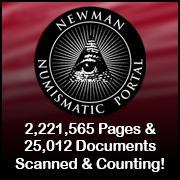
About UsThe Numismatic Bibliomania Society is a non-profit association devoted to the study and enjoyment of numismatic literature. For more information please see our web site at coinbooks.org SubscriptionsThose wishing to become new E-Sylum subscribers (or wishing to Unsubscribe) can go to the following web page link MembershipThere is a membership application available on the web site Membership Application To join, print the application and return it with your check to the address printed on the application. Print/Digital membership is $40 to addresses in the U.S., and $60 elsewhere. A digital-only membership is available for $25. For those without web access, write to: Terry White, Treasurer AsylumFor Asylum mailing address changes and other membership questions, contact Terry at this email address: terrywhite5475@yahoo.com SubmissionsTo submit items for publication in The E-Sylum, write to the Editor at this address: whomren@gmail.com BUY THE BOOK BEFORE THE COINSale Calendar |
- WAYNE'S WORDS: THE E-SYLUM OCTOBER 14, 2018
- NBS FOUNDING MEMBERS LIST UPDATE
- KOLBE & FANNING EPHEMERA SALE NO. 4 ANNOUNCED
- BRYCE BROWN NUMISMATIC LITERATURE OFFERINGS
- RICHARD STOCKLEY OFFERS DISCOUNT
- BOOK REVIEW: UNITED STATES PROOF COINS, VOLUME IV
- SEABY’S COIN AND MEDAL BULLETIN ON NEWMAN PORTAL
- A TYPICAL DAY AT THE NEWMAN PORTAL
- NOTES FROM E-SYLUM READERS: OCTOBER 14, 2018
- MORE ON THE 1930S DIE STRUCK SHELLS
- WORTHY COIN COMPANY START DATE
- VOCABULARY TERM: NIELLO
- SAMUEL BISPHAM (1796-1885)
- PRINCETON WORKSHOP ON SASANIAN COINS & HISTORY
- BANK NEGARA MUSEUM NUMISMATIC GALLERIES
- SELECTIONS FROM HOLABIRD OCTOBER 2018 SALES
- NUMISMATIC NUGGETS: OCTOBER 14, 2018
- WAYNE'S NUMISMATIC DIARY: OCTOBER 14, 2018
- HOLEY DOLLAR AND DUMP: MEASURE TWICE, CUT ONCE
- MAXIMILIAN FYSCHER WORLD WAR I PLAQUE
- THE OVEREND WWI FRENCH MEDAL COLLECTION
- HIDDEN MESSAGES IN HAY INTERNMENT CAMP NOTES
- BANK OF ENGLAND ANNOUNCES £50 NOTE CHANGES
- 'HIDDEN SECRETS' OF THE $1 BILL
- AUDIO: THE STORY OF MONEY
- LOOSE CHANGE: OCTOBER 14, 2018
- THE LARGEST COIN PYRAMID IN THE WORLD
Click here to access the complete archive a
Click here to unsubscribe (scroll down)
To comment or submit articles, reply to whomren@gmail.com
Content presented in The E-Sylum is not necessarily researched or independently fact-checked, and views expressed do not necessarily represent those of the Numismatic Bibliomania Society.
WAYNE'S WORDS: THE E-SYLUM OCTOBER 14, 2018
 New subscribers this week include: Erwin Leidolf, and Purush. Welcome aboard! We now have 5,776 subscribers.
New subscribers this week include: Erwin Leidolf, and Purush. Welcome aboard! We now have 5,776 subscribers.
Thank you for reading The E-Sylum. If you enjoy it, please send me the email addresses of friends you think may enjoy it as well and I'll send them a subscription (but let me know if they are located in the European Union). Contact me at whomren@gmail.com anytime regarding your subscription, or questions, comments or suggestions about our content.
This week we open with some NBS history, sales from three numismatic literature dealers, a book review, and updates from the Newman Numismatic Portal.
Other topics this week include the Worthy Coin Company, collector Samuel Bispham, numismatic workshops and museums, auction highlights, the Holey dollars and dumps, and World War I medals and plaques.
To learn more about Mint postcards, fantasy Channel Islands tokens, International Workers of the World strike scrip, the St. Ignatius In California medal, the Overend medal collection, non-buyer's remorse, and Teddy Bear Currency, read on. Have a great week, everyone!
Wayne Homren
Editor, The E-Sylum
NBS FOUNDING MEMBERS LIST UPDATE
Pete Smith submitted this update on his effort to identify early members of our Society. Thanks. -Editor
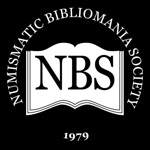 Two weeks ago I inquired about the founding members of the Numismatic Bibliomania Society who met in St. Louis in 1979. I have corresponded with George F. Kolbe who
started the society with Jack Collins. Kolbe recalls that there was a brief meeting in the hotel lounge followed by a dinner. People who attended were in agreement that there
should be an organized society for those who collect numismatic literature. He could not recall who was at the dinner.
Two weeks ago I inquired about the founding members of the Numismatic Bibliomania Society who met in St. Louis in 1979. I have corresponded with George F. Kolbe who
started the society with Jack Collins. Kolbe recalls that there was a brief meeting in the hotel lounge followed by a dinner. People who attended were in agreement that there
should be an organized society for those who collect numismatic literature. He could not recall who was at the dinner.
In the past three weeks I have corresponded with five people who recall being at the dinner and another five people who might have been there but were not. From these discussions, I have come up with a partial list of those who attended.
Those who were definitely at the dinner include Jack Collins, George Kolbe, Q. David Bowers, Keith Kelman, Denis Loring, and Jesse Patrick. Others who may have attended include John Bergman, Armand Champa, Jon Hanson and Cal Wilson.
Next year will be the 40th anniversary of our Society. I have been working with NBS Historian Joel Orosz to review the limited membership records. Perhaps a long ignored record will turn up to clarify this important list of founding members.
To read the earlier E-Sylum article, see:
LIST OF NBS FOUNDING MEMBERS SOUGHT (http://www.coinbooks.org/v21/esylum_v21n39a02.html)
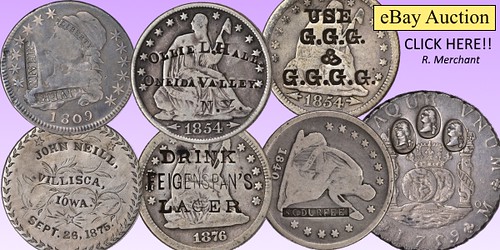
KOLBE & FANNING EPHEMERA SALE NO. 4 ANNOUNCED
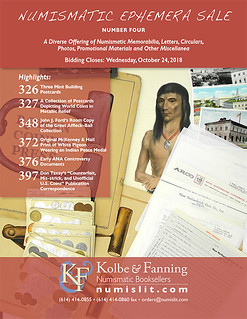 Numismatic ephemera holds a special place in my heart - these wisps of paper, little announcements, accompanying documentation, letters and other items not generally
saved or appreciated at the time are sometimes more rare and valuable than the numismatic items they describe. Kolbe & Fanning are holding another of their ephemera sales -
see the catalog for complete information. Here's the press release. -Editor
Numismatic ephemera holds a special place in my heart - these wisps of paper, little announcements, accompanying documentation, letters and other items not generally
saved or appreciated at the time are sometimes more rare and valuable than the numismatic items they describe. Kolbe & Fanning are holding another of their ephemera sales -
see the catalog for complete information. Here's the press release. -Editor
Kolbe & Fanning Numismatic Booksellers are announcing our fourth Numismatic Ephemera Sale, which includes 100 lots of memorabilia, short sale catalogues, photographs, letters, brochures, leaflets, booklets: all sorts of material that doesn’t necessarily fit well in a book auction but which is interesting nonetheless.
Items in the current sale include:
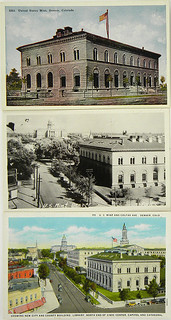
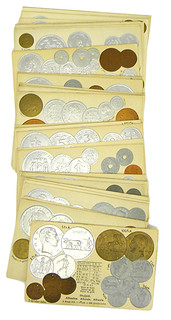
Lots 326 and 327
Lot 326: Three mint building postcards
Lot 327: A collection of postcards depicting world coins in metallic relief
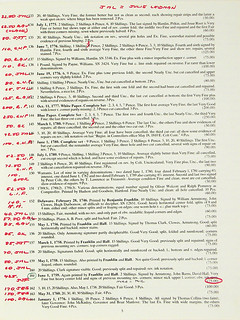
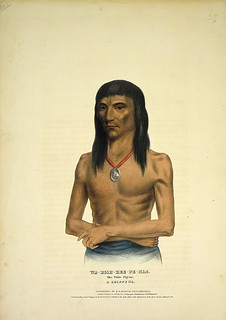
Lots 348 and 372
Lot 348: John J. Ford's room copy of the Great Afflect-Ball Collection
Lot 372: Original McKenney & Hall print of White Pigeon wearing an Indian peace medal
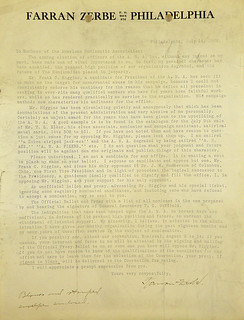
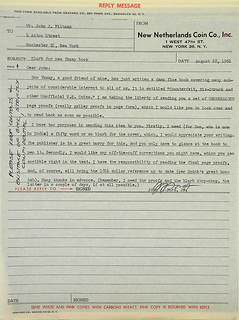
Lots 376 and 397
Lot 376: Early ANA controversy documents
Lot 397: Don Taxay's "Counterfeit, Mis-struck, and Unofficial U.S. Coins" publication correspondence
The catalogue is in PDF form only: there is no printed catalogue, nor is there online bidding. This is purely an old-school mail-bid sale. The catalogue may be downloaded from Kolbe & Fanning’s website at numislit.com .
THE BOOK BAZARRE
BRYCE BROWN NUMISMATIC LITERATURE OFFERINGS
Numismatic literature dealer Bryce Brown of Connecticut has new stock available on his web site. He sent this summary. Thanks. -Editor
I have updated my Numismatic Literature website to include new offerings. Notable items include:
- A deluxe edition of Wayte Raymond’s W.W.C. Wilson part 1 catalog, with 45 photographic plates
- A second W.W.C. Wilson part 1 catalog, a bound salesroom copy
- Eight Volumes of the American Journal of Numismatics from the Charles I. Bushnell & Virgil M. Brand libraries, bound in four volumes. Among these is Volume 3, which features the important “Levick plate” of early cents
- Thirty nine early Thomas Elder auction catalogs, 1908-1924, including numerous rare WWI era numbers, bound in three volumes
- An original Weyl catalog of the Jules Fonrobert collection part 2 (Mexico & Central America) in two volumes in half calf, ex. Virgil Brand library
- 1848 Sotheby’s Pembroke sale, priced and named, half morocco, ex. Edmund B. Wynn (N.Y. Stamp & Coin 2/1893 sale) and Virgil Brand libraries
- 1909 Sotheby’s Rashleigh sale, priced and named, bound by Spink & Son, ex. Virgil Brand library
- Breen’s 1977 “The Care and Preservation of Rare Coins” audio “talking book” record
- A bound set of original Albert A. Grinnell auction catalogs, by Barney Bluestone, 1944-1946
- The first 12 volumes of The Numismatic Scrapbook Magazine, 1935-1946, ex. Harry Bass
- Many other scarce and important auction catalogs, periodicals, and reference books
I welcome E-Sylum readers to browse my fixed price lists at http://brycebooks.squarespace.com/
RICHARD STOCKLEY OFFERS DISCOUNT
Numismatic literature dealer Richard Stockley of Canada is holding a sale. See the link below to peruse his stock and contact him via email at rstockley@videotron.ca. Here's his email announcement from October 11, 2018. -Editor
I need to move some titles so I am offering the following deal. Take 40% off all my stock that is listed on the ABEBOOKS site. Postage is, of course, extra. The sale will commence today and end at 3pm EST on 25 Oct. Please, no calls, emails only. Some titles are available in quantity so let me know if you want extra copies and I will let you know if it’s possible.
You will have to deal directly with me and not through the site or you will not receive the discount.
To view his stock on AbeBooks, see:
https://www.abebooks.com/bookseller/stockleysbooks

BOOK REVIEW: UNITED STATES PROOF COINS, VOLUME IV
Dealer and E-Sylum supporter Doug Winter of Portland, OR submitted this review of John Dannreuther's new book on U.S. proof gold. Thanks! -Editor
UNITED STATES PROOF COINS, VOLUME IV BY JOHN DANNREUTHER: A REVIEW
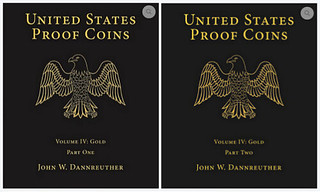 When it was released in 1988, Walter Breen’s Complete Encyclopedia of US and Colonial Coins was considered his magnum opus. But like the poorly-bound book itself,
the more you used the Breen reference, the more it fell apart. Clearly, as the years passed, it was evident that a new reference work was required for the misunderstood area of US
Proof coinage.
When it was released in 1988, Walter Breen’s Complete Encyclopedia of US and Colonial Coins was considered his magnum opus. But like the poorly-bound book itself,
the more you used the Breen reference, the more it fell apart. Clearly, as the years passed, it was evident that a new reference work was required for the misunderstood area of US
Proof coinage.
I’ve known John Dannreuther for longer than I care to admit and for close to 30 (?) years, he’s been telling me about his work on an all-encompassing reference on US Proofs; a book that would once and for all bury the inaccuracies of the Breen book and make order out of this messy area of the hobby.
I received JD’s new book(s) on Proof gold around a month ago and I’ve been treating them like I would a bottle of fine old Scotch. This isn’t a book that you sit and read in large gulps. It’s meant to sit on your shelf and get taken down a few times per week and—even then—read in short bursts.
There have been very few books on US coins which I regard as “game changers.” Crosby’s book on Colonials is certainly one as is Penny Whimsy. In the area of specialized books, there are dozens of books which have had huge impact but only within their little areas of focus. I regard the new Dannreuther book as a game changer and a book against which all future books on US coins will be measured.
The most important questions collectors will ask about Proofs are: “What is a Proof?” “How rare is a specific issue in Proof” and “What is it worth?” The Dannreuther books do a terrific job of answering the first two questions and wisely stay clear of the problems inherent with including values in reference works.
I have always had an affinity for the extremely rare early Proofs (those struck from the early part of the 19 th century through the beginning of numismatics as we know it in the late 1850’s). The Dannreuther book does a superb job of explaining early Proofs, through diagnostics and numismatic history. This includes going the extra mile with the especially complex Classic Head proofs.
The most difficult issues to determine their method of manufacture are gold dollars from the 1880’s. Even experts are often stumped by the difference between early business strikes (which appear fully prooflike) and genuine Proofs (which sometimes look like business strikes should). The Dannreuther book does a superb job of determining the differences between the two and through the use of clear images, shows the proper diagnostics for business strikes and Proofs.
Another complex area of Proof gold are the Matte/Sandblast issues of 1908- 1915. The reason for the use of these new finishes is properly explained and diagnostics are provided. I would personally have liked the book to show large images of the differences in textures and colors for each year, as well as images which show what a “ruined” Matte Proof gold coin looks like after it has been conserved. The author makes mention of this on page 688 but some accompanying images would have been helpful.
My only issue with this exceptional book is its bulk and size. The two volumes total 1031 pages and are housed in a slipcover. The sheer bulk of these books make using them somewhat difficult and I wonder if it wouldn’t have made more sense to have produced slimmer volumes which featured one denomination.
United States Proof Coins Volume IV is an essential addition to any collector’s library and I believe it is a book that, like Crosby on Colonials, will retain its usefulness a century or more past its date of publication.
The first three chapters are quite interesting and useful for all numismatists regardless of whether they collect or deal in the rare and valuable proof gold coins discussed in the rest of the two volumes. Chapter One is an "Introduction to Proof Coinage", followed by "Why and Where Were Proof and Master Coins Made?" and "How Were Proof and Master Coins Made?"
The book has been well worth the decades-long wait, and we'll all look forward to subsequent volumes in the series. Printed on thick glossy paper, the color photos throughout are a dream, with quite a few close-ups revealing important diagnostic details.
Measures of type rarity, date rarity and variety rarity are included for each piece. Up to a dozen or so significant examples are enumerated with detailed provenances. Mint records including die use and destruction documents have been consulted, as have the body of U.S. coin auction catalogs. JD has brought together all of the pertinent facts and thought through their implications for each piece.
It's no wonder this book was 40 years in the making. The effort shows. And now every one of us can be the beneficiary of that work. See the earlier article for ordering information. -Editor
To read the earlier E-Sylum article, see:
NEW BOOK: U.S. PROOF COINS VOL IV: GOLD (http://www.coinbooks.org/v21/esylum_v21n07a02.html)
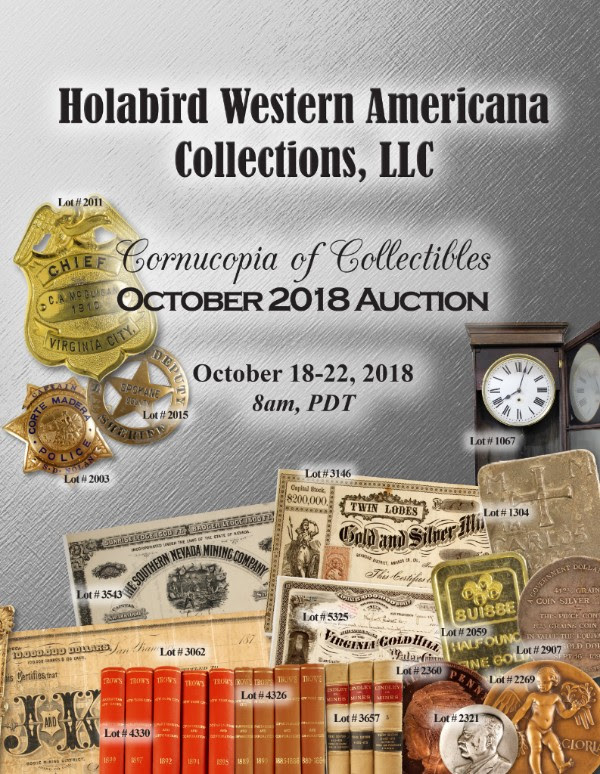
SEABY’S COIN AND MEDAL BULLETIN ON NEWMAN PORTAL
The latest addition to the Newman Numismatic Portal is Seaby’s Coin and Medal Bulletin. Project Coordinator Len Augsburger provided the following report. -Editor
 With the kind permission of Michael Gasvoda and Victor England of the Classical Numismatic Group (CNG), Seaby’s Coin and Medal Bulletin has been added to Newman
Portal. A house organ of the first rank, Seaby’s contained useful articles on British and ancient numismatics, news updates, society announcements, and, naturally, a monthly list
of items for sale. Published in London (readers were advised to use the Oxford Circus underground station), Seaby’s was focused on English collectors, but occasionally featured
important American content. R. W. Julian’s articles in the October and November 1962 issues, for example, established the English (Birmingham) origin of the 1791 Washington cents.
Seaby’s was acquired by the Classical Numismatic Group in 1991, which continues operations today, specializing in Greek, Roman, and British coins
With the kind permission of Michael Gasvoda and Victor England of the Classical Numismatic Group (CNG), Seaby’s Coin and Medal Bulletin has been added to Newman
Portal. A house organ of the first rank, Seaby’s contained useful articles on British and ancient numismatics, news updates, society announcements, and, naturally, a monthly list
of items for sale. Published in London (readers were advised to use the Oxford Circus underground station), Seaby’s was focused on English collectors, but occasionally featured
important American content. R. W. Julian’s articles in the October and November 1962 issues, for example, established the English (Birmingham) origin of the 1791 Washington cents.
Seaby’s was acquired by the Classical Numismatic Group in 1991, which continues operations today, specializing in Greek, Roman, and British coins
Image: R. W. Julian article, “The Digges Letters,” from the October 1962 issue of Seaby’s Coin and Medal Bulletin.
Link to Seaby’s Coin and Medal Bulletin on Newman Portal::
https://nnp.wustl.edu/library/publisherdetail/528776
Link to Classical Numismatic Group:
https://www.cngcoins.com/
A TYPICAL DAY AT THE NEWMAN PORTAL
In an email October 5, 2018, Newman Numismatic Portal Project Coordinator Len Augsburger described a typical day behind the scenes at NNP. -Editor
What Happens on a Typical Day at Newman Portal?
Here's a look behind the scenes on Thursday, October 4:
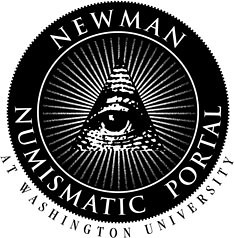 Len Augsburger, Newman Portal project coordinator at Washington University in St. Louis (WUSTL), worked with Simcha Kuritzky of the Maryland State Numismatic Association
to integrate electronic copies of their publication, The Maryland Numismatist, into NNP. Len also worked with author George Cuhaj on Cuhaj's monograph, Pennsylvania
Railroad Medal for Heroic Service. In between, Len processed portions of Eric P. Newman's electronic correspondence covering the period 2006-2017.
Len Augsburger, Newman Portal project coordinator at Washington University in St. Louis (WUSTL), worked with Simcha Kuritzky of the Maryland State Numismatic Association
to integrate electronic copies of their publication, The Maryland Numismatist, into NNP. Len also worked with author George Cuhaj on Cuhaj's monograph, Pennsylvania
Railroad Medal for Heroic Service. In between, Len processed portions of Eric P. Newman's electronic correspondence covering the period 2006-2017.
Nicole Fry, WUSTL library technical assistant, continued scanning a 30-year run of Seaby's Coin and Medal Bulletin, a British publication that has been opened with the kind permission of Classical Numismatic Group, the successor firm of Seaby's.
Shannon Davis, WUSTL digitization manager, worked with a vendor on the acquisition of a third scanning machine for our St. Louis scanning lab at Washington University.
At the American Numismatic Society (ANS), Internet Archive scanner Lara Jacobs continues scanning the S.H. & H. Chapman letterpress copy books, representing correspondence of this important Philadelphia firm from 1883 to 1890. The ANS provides space for Newman Portal equipment, in addition to making library material available for scanning. Meanwhile, contractor John Graffeo is processing scans from his recent visit to the U.S. National Archives and Records Administration in Philadelphia.
Our numismatic community liaison, Wayne Homren, continues to work with a number of potential NNP partners. At any time, discussions with approximately a dozen possible contributors are underway, and these will be announced in due course as they are concluded.
Finally, the software programming team, led by John Feigenbaum at Collectibles Technology Company, delivered a new "power search" capability, which, while a bit more complex, gives users greater capability to form more targeted search queries (try it out here).
To visit the Newman Portal, see:
https://nnp.wustl.edu/

NOTES FROM E-SYLUM READERS: OCTOBER 14, 2018
More on Testoons and Shillings
Last week David Powell questioned Allan Davisson's assertion that "Shillings were a Tudor innovation that began with the coinage reform under Edward VI," stating
that "Previously known as testoons, but of a similar twelve pence value, they originated c.1504 under Henry VII. "
David Hoover writes:
I am pretty sure Mr. Davisson knows as much about testoons as those who wrote in to say he was wrong about the first shillings. After all, just because another coin had the same value in pence does not mean it was the same coin. I am thinking that when testoons existed the name shilling did not so I would have to say he is technically correct.
I have always thought it was wrong myself when people would say that they are the same. There are an awful lot of coins of the same value with different names. I know that is not what the Royal Mint says, but how can something be something else that doesn’t exist yet?
Allan Davisson writes:
“The gold sovereign, the silver crown and the shilling piece were all Tudor innovations…” (Challis. The Tudor Coinage. P. 211)
Were I to rewrite the piece, I would say “formally began” rather than simply “began” under Edward VI. However, the point remains that there was no currency piece known as a “shilling” before the Edward VI reform.
Strictly speaking, the term is much older than the Tudors. It was a monetary measure used in Saxon times. It was not until Edward VI’s reign that the term was applied to a currency coin.
The testoon of Henry VII was based on the Italian term testone, a European denomination. The Henry VII piece “never became more than a token or trial issue…” (Challis) It was struck to a standard of 144 grains.
The testoon of Henry VIII was a debased issue and the demonetization of 1548 (Edward VI’s reign) converted them to groats. (Challis)
The actual shilling as we know it began at a 96 grain standard under Edward VI and after some small fluctuation essentially settled at 92 ¾ grains. Eventually, in the milled series, it ended up at 87 grains.
Thanks, everyone! -Editor
To read the earlier E-Sylum articles, see:
THE SHILLINGS OF ELIZABETH I (http://www.coinbooks.org/v21/esylum_v21n39a24.html)
NOTES FROM E-SYLUM READERS: OCTOBER 7, 2018 : Testoons and Shillings
(http://www.coinbooks.org/v21/esylum_v21n40a08.html)
Non-Buyer's Remorse
Douglas Saville writes:
“THE FINEST WORK ON GREEK COINS EVER PRINTED”
Dennis Kroh was almost certainly correct (as he was in many of his opinions) when he described Kraay and Hirmer’s magnificent “Greek Coins” thus. When I read Bill Daehn’s article about his acquisition of a (too?) reasonably-priced copy of this lovely volume in the Summer, 2018 issue of The Asylum I was reminded of my time at Spinks, London.
In the mid-1970’s Thames and Hudson, the original publishers of the book offered Spinks in London the remaining stock of the book - some 250 copies…… It had been published at £6.6. (six guineas, or £6.30 in today’s money) – for, probably, a ridiculously low “remainder” price. At the time Spink had published a significant number of books, reprinted several standard works, and I had purchased quite a few large libraries, so we were somewhat stretched. In 1966 we had purchased a large quantity of this wonderful book, and sold most, but still had stock in our warehouse…..After consideration, Howard Linecar and I declined the offer.
Thames and Hudson Ltd, sold these remaining copies to Harry Abrams Inc. of New York, who printed their own jackets, overprinted the title page with their name, and marketed the book in the US as their own publication. After a couple of years, they still had a large number left, and they offered those to us. We took them, and we repriced the book - at £10. It sold slowly….….and then, in due course it went out-of-print, and the price started to escalate…. until, in more recent years mint copies have been sold for $750 or more. A reasonably nice example can still be had for $450 or less.
The moral is, buy the book when you can get it for the published price, don’t wait until it is reduced in price, as it may never be reduced in price, but it might just go out of print and the price may well escalate, as most really good books often tend to do, especially in our area of interest. I have seen it happen so often.
How true! It has for years been my daydream to chance across a bookstore with a pile of these for sale at $10 apiece. It would be a nice way to finance a vacation after getting past my wife's you-are-not-going-to-buy-another-damn-book speech. -Editor
German Magazine Features Hobo Nickels
Original Hobo Nickel Society President Carol Bastable writes:
In a recent post on the OHNS Facebook page, Aleksey Saburov noted discovering an article about Hobo Nickels in the 27th. issue of the German publication "Magazin fur Herrenkultur". Google translates that to "Magazine for Men's Culture".
Nice. Carol provided these images. Thanks. The English edition is called The Heritage Post. -Editor
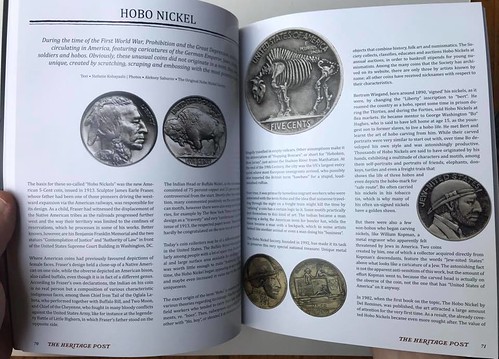
Withrow Defacing U.S. Currency
Regarding Treasurer Mary Ellen Withrow, O. T. Thompson writes:
It was in 1999 or 2000 when Ms. Withrow came to an ANA to sign autographs. I had just started stamping Viking ships on my currency (To commemorate the Viking's discovery of America 2,000 years prior.) so I thought I'd ask her to sign one. When I placed it in front of her, she saw the ship stamp and asked, "Did you do this?"
I replied, "Yes, Ma'am, I did."
She responded, "You know we frown on people defacing U. S. currency."
I smiled and said, "You mean like signing their name to currency with a permanent ink pen?
She paused, looked up, then smiled and said, "I gotcha.", and signed it.
I'll bet Ms. Withrow has autographed more currency than ANY other government official!
Cool story. Thanks! -Editor
To read the earlier E-Sylum article, see:
ARTICLE PROFILES MARY ELLEN WITHROW (http://www.coinbooks.org/v21/esylum_v21n40a13.html)
More on the Fantasy Channel Islands Tokens
Scott Semans writes:
You were looking for a Numismatics International Bulletin article on these. Perhaps this is a reference to a letter I had published in the January, 1980 issue asking for information on them. I received numerous responses, none citing an earlier article, though something could have been published subsequently.
I received numerous responses. Someone sent me a typed copy of letters which appeared in the November and December, 1972 issues of Seaby's Bulletin, which may be the earliest published reference to the series. The more interesting response was from Richard Mayne, "(President, C.I. Occupation Society; Vice-President, Société Jersiase; author of 'Jersey Occupied' pub. by Jarrold's 1970)," who pronounced them clearly spurious. Jürgen Mikeska of Friedrichsdorf, Germany gave a similar opinion in his article from Geldgeschichtliche Nachrichten #74 (date?) which included photos of 12 different uniface pieces. He had contacted numerous parties in Britain and Germany who knew nothing of them, and included a 1979 letter from R. W. Higginbottom, curator of the museum of the Société Jersiase, who pronounced them "recent forgeries. . . since 1960 . ."
Some pages torn from an undated price list which offers numerous Nazi pins, badges, medals, etc. at too-cheap prices, only some items designated "replicas," suggest that they were made by someone whose specialty was fake Nazi memorabilia. Mikeska pictured twelve different in the series, and neither the unattributed sales catalog nor my own records show any additional types, so that may be the extent of the series.
Scott provided the following images. Thank you! -Editor
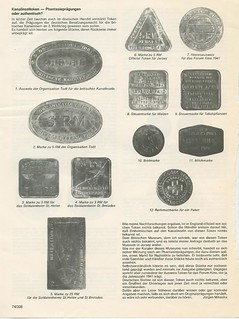
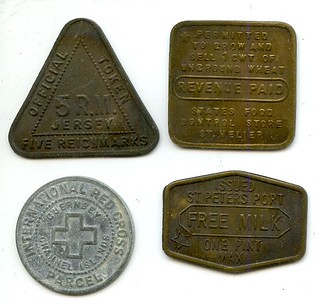
To read the earlier E-Sylum article, see:
FANTASY JERSEY FIVE REICHMARK TOKEN (http://www.coinbooks.org/v21/esylum_v21n40a09.html)
High Cost of Living Postcard
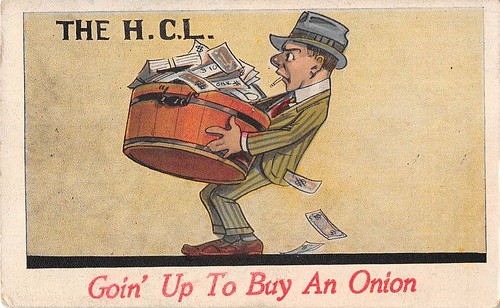
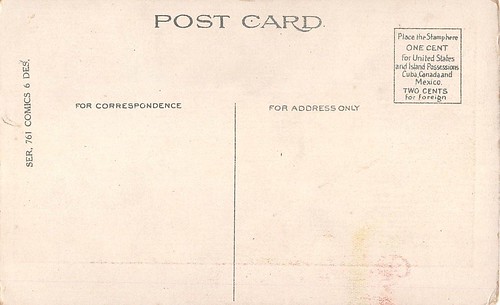
Carol Bastable writes:
In reference to the 5 billion mark, this is a postcard I picked up on eBay within the last month. I enjoy collecting various types of numismatic ephemera and had found this one unusual as numismatic postcards go. As you will see, there is a reference to inflation with the high cost of an onion.
In my high school history class I remember learning about people taking shopping carts full of money to the grocery store to buy food in post WWI Germany. German money was printed at will to pay off war debts and lost pretty much all its value as a result. When I bought this, I felt the card illustrated that history lesson very well. However I am not certain this is actually a reference to Germany or just a satirical general statement. The money is designed to be generic and could represent almost any country.
The H.C.L. stands for the high cost of living. The card is not postmarked but the reference to island possessions, Cuba Canada, and Mexico might give a lead as to date. The very early 1900's cards just reference postage for domestic with one cent and foreign with 2 cents. The added locales on this card may support a different and later time period.
Interesting. Thanks! -Editor
To read the earlier E-Sylum article, see:
NUMISMATIC NUGGETS: OCTOBER 7, 2018 : 1923 German 5 Billion Mark Banknote
(http://www.coinbooks.org/v21/esylum_v21n40a24.html)
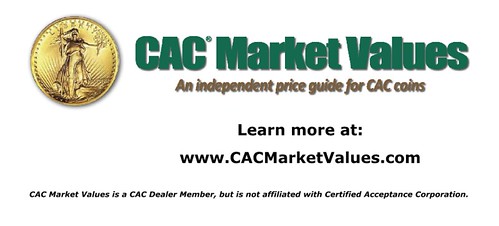
MORE ON THE 1930S DIE STRUCK SHELLS
Gawain O'Connor writes:
About those items Mike Sanders mentioned. There have been a few discussions of them on the PCGS forum, and "The Penny Lady" Charmy Harker said she is writing an article.
I have one of them and vaguely remember the seller mentioning they were originally promoted by the Boy Scouts, but I have no reference to back that up. Anyway, here are a couple links and pictures.
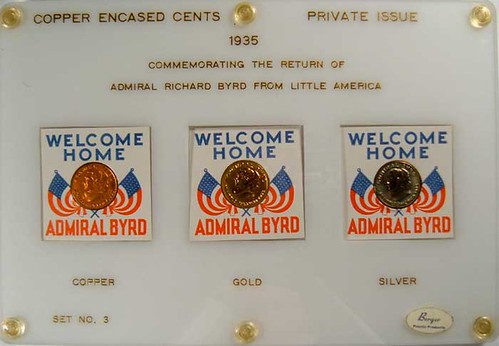
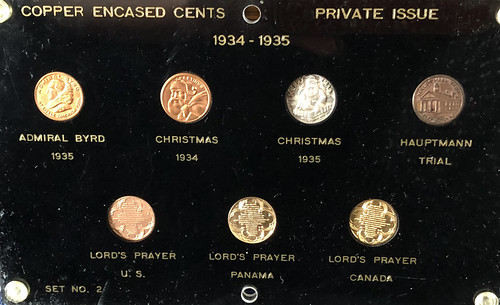
To read the PCGS forum discussions, see:
capped cents from 1934? (exonumia question)
(https://forums.collectors.com/discussion/721036/capped-cents-from-1934-exonumia-question)
https://forums.collectors.com/discussion/comment/12013981#Comment_12013981
Thanks. One of the respondents wrote that these were sold by the Tatum Stamp and Coin Company. We'll look forward to Charmy's article. -Editor
Ken Barr writes:
Wikipedia attributes these to "local coin dealer" Louis Werner. I've also seen them attributed to Tatham Stamp and Coin, but without supporting references. Since Tatham published numerous catalogs, I presume anything of this nature that they produced would be listed in one or more of them ... perhaps some E-Sylum reader with a Tatham catalog collection could check.
I have the Morro Castle, Hauptmann trial and Byrd Expedition pieces in my collection, but have not seen the Joe Louis or Christmas items ... something else to look for on my "bucket list". Somewhere in my vast Exonumia Closet I have a custom Capital Plastic holder with eight capped cents in it. I believe that they are only the three mentioned above, but with various metals used for the cap (bronze, brass and silver, if I remember correctly).
To read the Wikipedia article (scroll down to "Capped cents"), see:
Penny (United States coin) (https://en.wikipedia.org/wiki/Penny_%28United_States_coin%29)
To read the earlier E-Sylum article, see:
QUERY: ADMIRAL BYRD DIE SHELL INFORMATION SOUGHT (http://www.coinbooks.org/v21/esylum_v21n40a10.html)
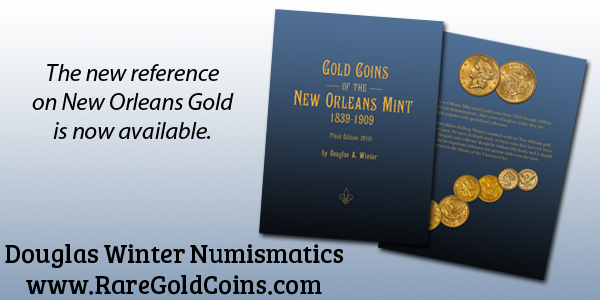
WORTHY COIN COMPANY START DATE
Regarding the article on Massachusetts dealer Corrado Romano of Romano's Coin Shop and the Worthy Coin Company, Michael Greenspan writes:
The bio in last week’s issue reminded me of a token issued by the Worthy Coin Corp to commemorate their 50th anniversary, 1938-1988. That seems to dispute the 1943 start date shown in the bio.
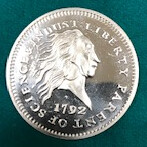
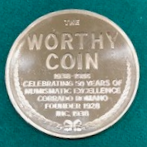
Mike also kindly provided the below transcription of the legends. Thanks! -Editor
The obverse depicts a plugged bust of Liberty with: LIBERTY PARENT OF SCIENCE & INDUST:around. Dated 1792
The verbiage on the reverse is: THE/WORTHY/COIN/1938-1988/CELEBRATING 50 years OF/NUMISMATIC EXCELLENCE/CORRADO ROMANO/FOUNDER 1928/INC. 1938
To read the earlier E-Sylum article, see:
DON CORRADO ROMANO (1903-1984) (http://www.coinbooks.org/v21/esylum_v21n40a12.html)
I also reached out to researcher John Lupia, who wrote the original article. -Editor
John Lupia writes:
If Corrado Romano made the claim that Worthy Coin was established in 1938 it must have a basis in reality since he had no reason to make the statement otherwise. He was also a very honest person as was his son. He might have formed the Worthy Corporation for legal and financial purposes in 1938 since I did find a Worthy Coin Corporation advertisement, located at 184 Summer Street, Dept. 35, Boston, Massachusetts, Popular Mechanics, Vol. 71, No. 5, May (1939) : 38A 1st Column bas de page. I see this same ad as early as April 1939. I did not find any mention of Worthy Coin in The Numismatist in the 1930's, i.e., 1938-1939. The same with Hobbies, and Numismatic Scrapbook. Romano may have formed the corporation but still traded as Romano's Coin Shop as the FRAUDULENT cover dated July 1938 indicates.
Perhaps someone has a FPL, invoices or other materials dated to 1938 that bear the new corporate name Worthy Coin. When it emerges outside of the Popular Mechanics ads in a more substantive form is an interesting research project. He seems to have been flying under the wire to avoid conflict with Postmaster Farley by changing the company name and address. After reestablishing his business as Worthy Coin without complaints he was in the clear and became popularly known in 1940's.
To read the earlier E-Sylum article, see:
DON CORRADO ROMANO (1903-1984) (http://www.coinbooks.org/v21/esylum_v21n40a12.html)

VOCABULARY TERM: NIELLO
Dick Johnson submitted this entry from his Encyclopedia of Coin and Medal Terminology. Thanks. It's a rare term often overlooked by collectors. -Editor
Niello. A design entirely of engraved lines. Niello medals have a flat background or field which is engraved (CISELE). They can be struck from dies which have very fine lines or niello medals can be hand engraved (one at a time). Niello dies must be handled with extreme care, since they are entirely of fine raised lines they are susceptible to damage.
Early niello objects, including medals, had the incised lines filled with a material composed of copper, lead and sulphur of borax – a form of black FILL-IN which was fired and polished. Such objects lacked modulated relief as all niello is biplanar – of two planes – incised lines in a flat surface with a fill-in of the incised lines.
The modern photoengraving process can produce medals of this type (PHOTOETCHED) from a black-and-white drawing – and the Paris Mint has issued numerous medals in this cartoon-like style – however the process is not widely used elsewhere in modern times. True niello has the black fill-in of the sulphur/borax composition. An imitation niello would be made in modern times with black enamel or crayon fill-in. A bas-relief model is not required for a niello medal, only a drawing.
CLASS 07.8Looking for the meaning of a numismatic word, or the description of a term? Try the Newman Numismatic Portal's Numismatic Dictionary at: https://nnp.wustl.edu/library/dictionary
Or if you would like a printed copy of the complete Encyclopedia, it is available. There are 1,854 terms, on 678 pages, in The Encyclopedia of Coin and Medal Technology. Even running two a week would require more than 19 years to publish them all. If you would like an advance draft of this vital reference work it may be obtained from the author for your check of $50 sent postpaid. Dick Johnson, 139 Thompson Drive, Torrington, CT 06790.

SAMUEL BISPHAM (1796-1885)
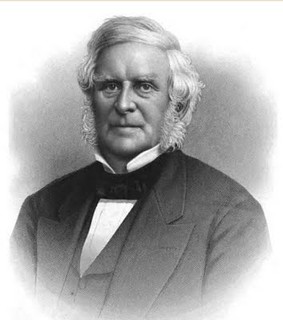 Samuel Bispham (1796-1885), was born on October 14, 1796, on Market Street, Philadelphia, son of Samuel Bispham (1753-1808), a hatter, and Anna Ellis Bispham. His
grandfather Joshua Bispham (1706-), came to America 1738 from Bispham, Lancashire, England and settled as a farmer in Moorestown, Burlington County, New Jersey. There he married
Ruth Atkinson (1718-). They had two sons Samuel and Joseph. Samuel Bispham, Sr. came to Philadelphia with his younger brother Joseph Bispham in 1772. During the yellow fever
epidemic 1798-1799 in Philadelphia, Samuel Bispham, Sr., and his family moved to the family farm in Moorestown. Adolescent Samuel used to travel into Philadelphia to help sell the
farm produce.
Samuel Bispham (1796-1885), was born on October 14, 1796, on Market Street, Philadelphia, son of Samuel Bispham (1753-1808), a hatter, and Anna Ellis Bispham. His
grandfather Joshua Bispham (1706-), came to America 1738 from Bispham, Lancashire, England and settled as a farmer in Moorestown, Burlington County, New Jersey. There he married
Ruth Atkinson (1718-). They had two sons Samuel and Joseph. Samuel Bispham, Sr. came to Philadelphia with his younger brother Joseph Bispham in 1772. During the yellow fever
epidemic 1798-1799 in Philadelphia, Samuel Bispham, Sr., and his family moved to the family farm in Moorestown. Adolescent Samuel used to travel into Philadelphia to help sell the
farm produce.
In 1808, after the death of his father he worked for William Carman's grocery store on Market Street. He stayed there until 1810 then entering the firm of John Snyder, also on Market Street, working as a bookkeeper and salesman.
In 1815, he became partners with Jacob Alter, opening a grocery store, Alter & Bispham, 825 Market Street.
In 1830, Atler retired and Bispham became sole proprietor.
In 1834, he purchased the building at 629 Market Street, from Horner & Wilson. At the formation of the Henry Clay Whig Party Samuel Bispham joined as a loyal member until its dissolution in 1860.
On December 25, 1823, he married Maria Stokes (1796-1880) at Burlington, New Jersey. They had six children...
In 1851, he brought his two sons into the business forming Samuel Bispham & Sons, wholesale grocers and commission merchants in Philadelphia, Pennsylvania.
His coin collection was sold by the Chapman Brothers from February 11-12, 1880, at Bangs & Company, New York. The 38 page catalogue comprised 1024 lots. The 1794 Silver Dollar sold for $27. The 1836 Gobrecht Dollar sold for $42.10. Chalmers Shilling $5.50. 1815 Half Eagle $150. Wyon's Immune Columbia Pattern $36. Proof Washington Before Boston $7.50. Three Kettle brass imitation tokens of U. S. $2.50 and $5 gold pieces Lot 797 sold for 6 cents each.
He died on October 4, 1885, ten days before his 89th birthday at his home 263 North 6th Street, Philadelphia. He is buried at Laurel Hill Cemetery, Philadelphia.
To read the complete article, see:
BISPHAM, SAMUEL
(https://sites.google.com/a/numismaticmall.com/www/numismaticmall-com/bispham-samuel)
The entire inventory of the Lupia Numismatic Library is for sale. Individual items will be available before the remaining archives are broken up into parcels sold at philatelic auctions in the U. S. and Hong Kong. Check NumismaticMall.com frequently as dozens of new items with estimates will be posted daily until everything is sold.
All inquiries will be given prompt and courteous attention. Write to: john@numismaticmall.com .
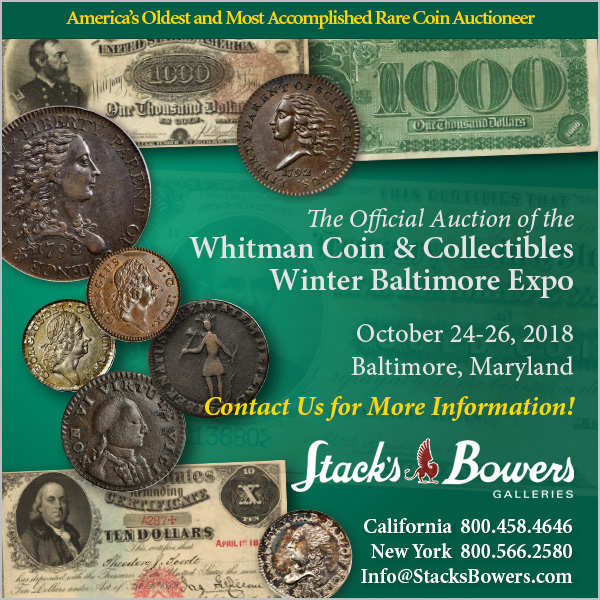
PRINCETON WORKSHOP ON SASANIAN COINS & HISTORY
Alan Stahl, Curator of Numismatics at the Princeton University Firestone Library submitted this announcement of an upcoming workshop on Sasanian coinages. -Editor
 On Saturday, November 3, the Princeton University Numismatic Collection will host a day-long workshop on Sasanian and related coinages in conjunction with the
University’s Sharmin and Bijan Mossavar-Rahmani Center for Iran and Persian Gulf Studies.
On Saturday, November 3, the Princeton University Numismatic Collection will host a day-long workshop on Sasanian and related coinages in conjunction with the
University’s Sharmin and Bijan Mossavar-Rahmani Center for Iran and Persian Gulf Studies.
The workshop will take place in 202 Jones Hall from 10 a.m. to 5:30 p.m.; it is open to the public without charge. It will feature presentations from the world’s leading experts on the coinage of Rome’s rival to the east and include a special exhibition of coins from the collection of Robert W. Schaaf, recently acquired by Princeton with the generous support of Anahita Naficy Lovelace ’75 and the Friends of the Princeton University Library.
Those planning to attend should RSVP to iran@princeton.edu by October 25 to ensure seating and reserve a free lunch. Anyone wishing further information can contact Alan Stahl, Princeton’s Curator of Numismatics, at astahl@princeton.edu or the Mossavar-Rahmani Center for Iran and Persian Gulf Studies at iran@princeton.edu.
BANK NEGARA MUSEUM NUMISMATIC GALLERIES
This article from the New Straits Times highlights numismatic exhibits at the Bank Negara Museum and Art Gallery in Kuala Lumpur, Malaysia. -Editor
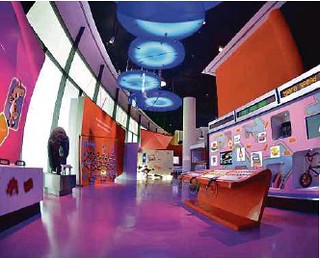 It is not every day that one gets to become a counterfeit detector agent to check for counterfeit money. Well, today I have been given the chance. Save for the humming
of the airconditioner, the room I am in is so quiet and cold. I slip on my glasses. In front of me is a device, about the size of a brick, that emits purple-coloured UV light. My
task is to check the authenticity of a RM50 banknote.
It is not every day that one gets to become a counterfeit detector agent to check for counterfeit money. Well, today I have been given the chance. Save for the humming
of the airconditioner, the room I am in is so quiet and cold. I slip on my glasses. In front of me is a device, about the size of a brick, that emits purple-coloured UV light. My
task is to check the authenticity of a RM50 banknote.
To the untrained eye, the note may look identical to other banknotes but there are several security features that will tell me if it is a genuine banknote. For instance, the design patterns are of songket-weaving, which are featured prominently in the background and edges of the banknote.
Setting down the banknote, I feel for the diamond-shaped marking with a layer of tactile ink printed on the top left corner of the note. Next, I put the note under the UV light and look for the watermark portrait of Malaysia’s first Prime Minister, Tunku Abdul Rahman, on the obverse side. At the base of the watermark, the numeral 50 must be clearly visible under bright light.
Things get a little exciting from here: Under the UV light, I have to look for the holographic stripe that has the denomination 50 and the hibiscus flower. When I tilt the banknote slightly, I can see the holograph effect with its multi-coloured spectrum. This RM50 note has passed the test; it’s a genuine note.
Tired of squinting at the micro-letterings on the note, I decide to head out to the RM1 Million Tunnel. Here, I feast my eyes on all four generations of banknotes used in the nation.
So where am I? This is the Children’s Gallery of the Bank Negara Malaysia Museum and Art Gallery in the Sasana Kijang building on Jalan Dato’ Onn in Kuala Lumpur.
Other Galleries
But that’s not the only cool gallery here. There are six: Numismatic Gallery where the Children’s Gallery is located, Bank Negara Malaysia Gallery, Economics Gallery, Islamic
Finance Gallery and an art gallery. Children’s gallery. The Economics Gallery (left) and the Art gallery .
At the Numismatic Gallery, I learn about the early history of money, when objects of different shapes and sizes were commonly accepted as currency in the region. Objects such as cowrie shells were used by early humans as metal tool money (in the shape of knife and spade) like the ones used in China.
Those keen to learn about barter trade can choose to become early traders in this section. Selecting a role as an early Chinese merchant from the Ming dynasty, who has just arrived from China with precious goods like tea and silk, my goal is to trade it with a fellow merchant for spices.
Next, I move to another section where coins and notes from the early days are on display. I see well-preserved gold and silver in different shapes, sizes and weight formerly used as a form of currency. One particular piece catches my eyes.
The Tin Animal Money, a form of currency used by the royals of the Malay Peninsula in the 15th century, is on display here. Crocodile, beetle and chicken are some of the common shapes.
Also on display are currencies used during the British colonial days as well as those from the Japanese Occupation in Malaya.
The museum is packed with interactive displays, fancy artwork, artefacts and information cards detailing the exhibits. At each gallery you may also find a smaller room with more interactive displays, like the one in the Bank Negara Malaysia Gallery. In one, I hop on a stationary bike and pedal at a certain pace to access information about the history of money.
To read the complete article, see:
Six galleries on money matters
(https://www.pressreader.com/malaysia/new-straits-times/20181011/282303911092438)

SELECTIONS FROM HOLABIRD OCTOBER 2018 SALES
Here are some items that caught my eye in the upcoming Holabird sale. -Editor
1905 International Workers of the World Strike Scrip
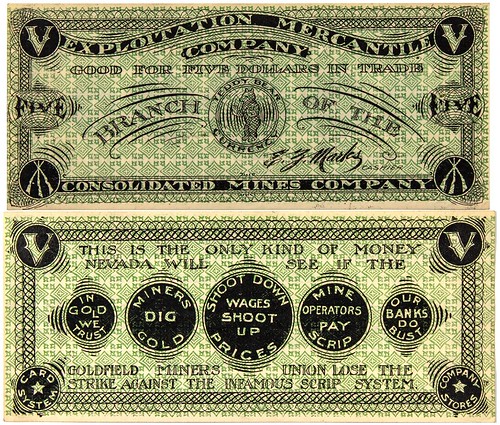
In 1905 the International Workers of the World (IWW or Wobblies) was created. In 1906 Goldfield had suddenly emerged as the biggest, most important, richest mining area in the United States. It would make a great place for the IWW to flex its muscles. In December of 1906 and January of 1907 they orchestrated small strikes for higher wages and it looked like the union would win this victory. But at the same time George Wingfield was gaining strength among the mine owners. He has become the most important owner, powerful and was unscrupulous. He convinced Governor Sparks to get Teddy Roosevelt to call in Federal Troops. He manipulated a jury into finding the strike leaders guilty of various crimes. The strike utterly failed.
This scrip was one of the propaganda tools that the unions used. Spend your cash at the [fanciful] Exploitation Mercantile Company of the Consolidated Mines Company. This represented the company stores that the miners could use their scrip at. You would be an ‘E. Z. Mark’ if you went along with this scheme.
The back just reiterates what will happen if the mine owners get their way! Not only will the miners suffer, but the entire financial system will fall apart. The final interesting note is the crossed rifles in the bottom corner of the obverse. These must have been used after the Federal troops were called in to quell the strike. City: Goldfield, Esmeralda State: Nevada Date: HWAC# 99441
A fascinating piece of labor history - "Teddy Bear Currency". -Editor
To read the complete lot description, see:
Extra Rare Goldfield IWW Strike Scrip
(https://holabirdamericana.liveauctiongroup.com/Extra-Rare-Goldfield-IWW-Strike-Scrip_i31464113)
Fifteen Cent Fractional Currency Note
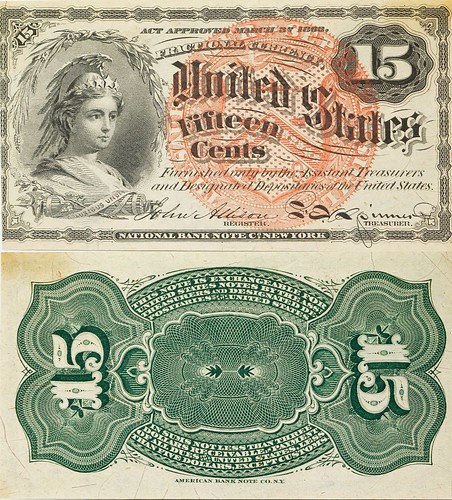
Freidberg 1275sp. Allison-Spinner. Uncirculated, stain in corner. City: State: Date: HWAC# 75074
I'm a Baby Boomer, so I might as well talk like a hippie. It still really blows my mind that the United States government issued paper money in the denomination of fifteen cents. Wow, man. Nice example. -Editor
1995 Series US $10 Error Note, Unprinted Back
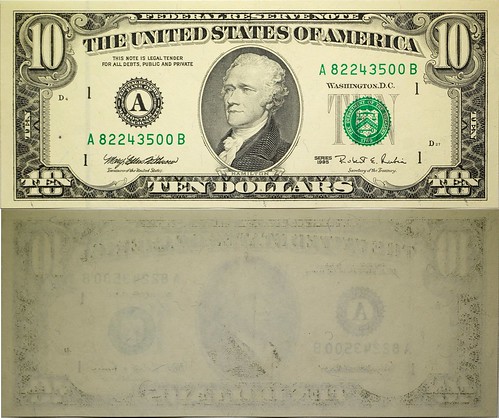
complete unprinted back, 1995 series, A, crisp uncirculated. sn A822434500B. This series not listed in Bart, Paper Money Errors, 2003. City: State: Date: HWAC# 75515
A great error note. -Editor
To read the complete lot description, see:
US $10 Error Note, Unprinted Back
(https://holabirdamericana.liveauctiongroup.com/US-10-Error-Note-Unprinted-Back_i31464119)
St. Ignatius In California U.S. Mint Medal
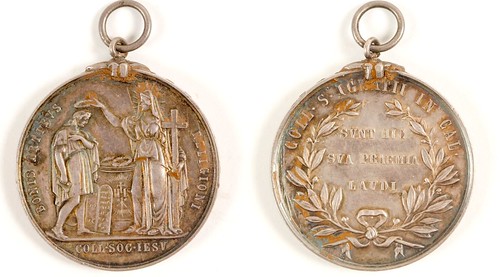
Round white metal. Julian SC-48. Salvatore Falcone Collection. City: State: California Date: 1881 HWAC# 81574
An unusual U.S. Mint medal. Can anyone tell us the story behind this one? -Editor
To read the complete lot description, see:
US Mint Medal-St. Ignatius In California
(https://holabirdamericana.liveauctiongroup.com/US-Mint-Medal-St-Ignatius-In-California_i31464137)

NUMISMATIC NUGGETS: OCTOBER 14, 2018
Here's a selection of interesting or unusual items I came across in the marketplace this week. Tell us what you think of some of these. -Editor
1813 New South Wales Fifteen Pence (Dump)
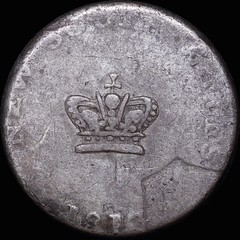
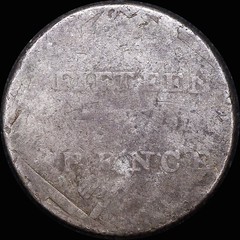
As one of the first coins struck on Australian soil, this incredibly rare coin is fundamental to any collection of Australian coins.
The historical importance of the Dump is often overlooked, however it played just as much of a role in solving New South Wales' currency woes as the Holey Dollar. The way Henshall cut and struck the Dump determined whether both coins remained in circulation.
The holey dollars and the "dump" cut out to make the hole were important makeshift answers to the serious problem of circulating coinage. One overweight Spanish dollar became two underweight circulating coins that wouldn't be melted down for their intrinsic value. This piece is from the stock of Andrew Crellin's Sterling & Currency. A decent well-circulated example. See an article from his blog elsewhere in this issue about the calculations and tradeoffs involved in cutting the host coin. -Editor
To read the complete item description, see:
New South Wales 1813 Fifteen Pence (Dump) Very Good
(https://www.sterlingcurrency.com.au/items/new-south-wales-1813-fifteen-pence-dump-very-good)
1838 J-73 Pattern Half Dollar
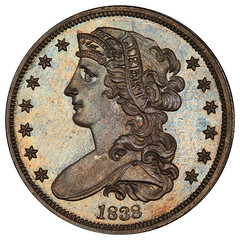
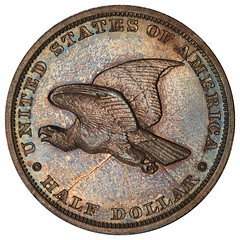
1838 50C J-73 ORIGINAL PCGS PR64 CAC
It's already sold, but check out this great 1838 pattern half dollar I saw on the web site of E-Sylum supporter Harry Laibstain Rare Coins. A beautifully toned piece. -Editor
To vsit the HLRC web site, see:
http://hlrc.com/
1870 Costa Rica Gold 10 Pesos
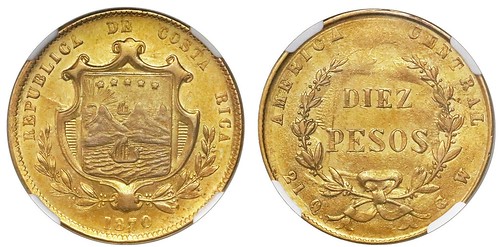
Costa Rica, 10 pesos, 1870GW, NGC MS 61. KM-115. Lustrous and deep, rich gold, with slightly crude fields per the type (also with central die-clashing), extremely rare in this quality (one of just two in Mint State in the NGC census, the other being an MS 62). NGC #4822204-003
From the Daniel Frank Sedwick Treasure Auction 24, November 1-3, 2018. -Editor
To read the complete lot description, see:
138 Costa Rica, 10 pesos, 1870GW, NGC MS 61.
(https://auction.sedwickcoins.com/Costa-Rica-10-pesos-1870GW-NGC-MS-61_i31506848)

WAYNE'S NUMISMATIC DIARY: OCTOBER 14, 2018
Steve's September 2018 Beauties
First, to clear up some old business, here are a couple images provided last month by Steve Bishop that I didn't manage to get into a diary. He brought these to the September
2018 meeting of our northern Virginia numismatic social group Nummis Nova. Steve's an active collector and eBay buyer who often brings interesting new purchases to our
dinners.
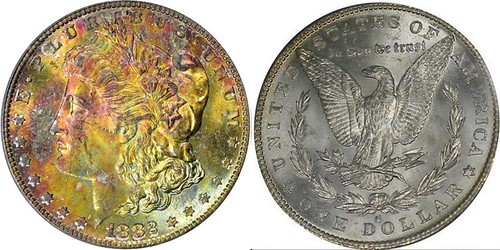
1882-S Morgan PCGS MS64 Toned
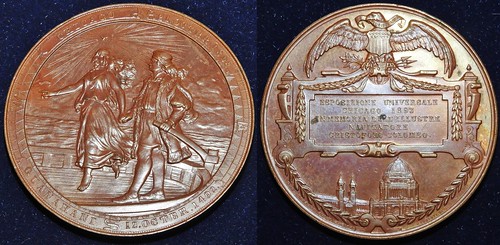
1892 Danish Colombian Exposition Medal
The dollar looked nice in person - this image is yellowy. Great medal. There is such a great variety of these that I'm still coming across ones I hadn't seen before.
October 2018 Nummis Nova
 Fast forward a month to October 9, 2018. After work I headed to The Esposito's Restaurant in Fairfax, VA. Joe Esposito was our host and no, it's not his
restaurant nor is he in any way related to the owners. But that didn't stop us from kidding about it all evening.
Fast forward a month to October 9, 2018. After work I headed to The Esposito's Restaurant in Fairfax, VA. Joe Esposito was our host and no, it's not his
restaurant nor is he in any way related to the owners. But that didn't stop us from kidding about it all evening.
I was the first of our group to arrive. Eric Schena pulled into the parking lot before I'd even exited my car. I was nursing a knee injury all evening and walking was painful. But I took a seat at our table and had a wonderful time.
I sat next to our host Joe Esposito and learned that sales of his new book are going very well. The hardbound first edition of Dinner in Camelot is nearly sold out. He and his wife were at the recent History Book Festival in Lewes, Delaware. It's a first-class event I wasn't aware of before. Check out their web site for more information: www.historybookfestival.org .
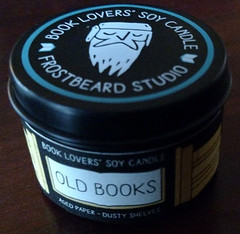 Joe brought me a gift from the festival - the "Book Lovers' Soy Candle" to evoke the scent of Old Books - aged paper, dusty shelves. I'm not sure my
wife would appreciate that. I asked if they sold an "Old Man Smell" candle, too. We've already got enough of those scents around here.
Joe brought me a gift from the festival - the "Book Lovers' Soy Candle" to evoke the scent of Old Books - aged paper, dusty shelves. I'm not sure my
wife would appreciate that. I asked if they sold an "Old Man Smell" candle, too. We've already got enough of those scents around here.
Speaking of old men, one of the books I brought along I'd chosen randomly from my shelves at home: Fireside Yarns / 1001 Nights / Reminiscences of an Old Coin Man by Paul Dore Burke. Published in 1932, I'm sad to admit I've never actually found time to read it. Is anyone familiar with it? Glancing through I saw THE CANINE NUMISMATIST on p71.
I also brought along a copy of Peter Bertram's Confederate Numismatica Supplement One.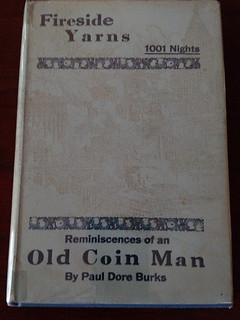
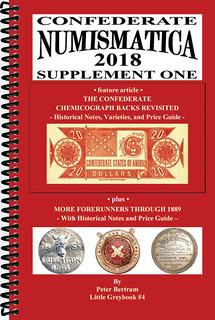
I passed around a couple small collections of U.S. paper money. The first was a group of notes found in circulation which bear some sort of overstamped image or slogan, such as "SPENT BY LAWFUL GUN OWNER", or a cartoon bubble making George Washington say "I GREW MARIJUANA."
Simce I mentioned a note signed by Treasurer Mary Ellen Withrow last week, I brought some notes signed by Bureau of Engraving and Printing engravers Tom Hipschen and Ken Kipperman.
Another little item I brought along was something I picked up at the PAN show last month. It's shiny and doesn't photograph well, but it's a thin metallic version of a $100 bill that makes a nice numismatic bookmark. Thanks to Pat McBride - he'd gotten these to give to the kids at the show, but let me snag a couple.
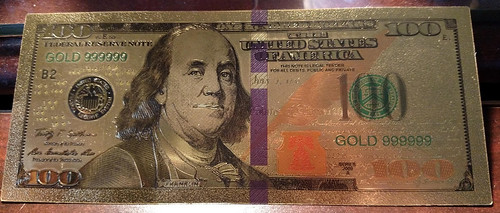
It hadn't taken long for the table to fill up. Other attendees included Dave Schenkman, Gene Brandenburg, Tom Kays, Mike Packard, Julian Leidman, Roger Burdette, Steve Bishop and Jon Radel.
Next up is Tom's account from the meeting.
Tom Kays' Perspective
"Numismatic Nuggets” – A small addition to Wayne’s Numismatic Diary with Perspective from the Opposite Side of the Table
– Tom Kays
By now Wayne has written in his Numismatic Diary about the wide assortment of fantastic numismatic memorabilia displayed at The Espositos, a restaurant of no particular association with our Nummis Nova November dinner host, that distinguished author and scholar, Joe Esposito. Often we sit at large tables with different sidebar conversations held at the ends and middle, so that just one account of what we discussed may miss what happened over on the far side of the table.
Wayne brought a modern collection of notes with counterstamps, like chop marks of old. Included were “Where’s George” notes, and many others of less well known origin. You see, it is extremely difficult to impress the Nummis Nova diners, who have seen all manner of coins, tokens, notes, numismatic books, and ephemera, over the past years of dinners. Imagine what you would need to bring to impress us each month. Some of us have been through the best of our collections, yet need to maintain suitable dinner show-and-tell conversational skills, often with whatever none of the bunch has seen. It takes a special skill to stay fresh and engaging with numismatic trivia about the utter ends of our collections.
From my perspective I photographed a very special monogrammed note owned by Gene Brandenburg and held in his great esteem for years. Once upon a time, Julian Leidman, a Professional Numismatic Consultant these past 50 years and the retail genius behind Bonanza Coins, purchased a lot of circulated silver certificates, something like 13,000 of them in all. He made his mark on one such note from the hoard and (I presume) gifted this shortest of “Short Snorters“ with his initials to Gene years ago. It would appear Gene has carried this monogrammed silver certificate for years, because the note has separated into two pieces, right between “George” and “Washington.”
Gene brought this treasure to the November dinner and asked Julian to sign the torn half as well, so as to be sure both pieces bear the impressive “JL” seal. Julian did in front of us as authentication witnesses, and I photographed Gene looking triumphant as he finagled Julian into doubling his inventory of genuine “JL” signed notes for nothing.
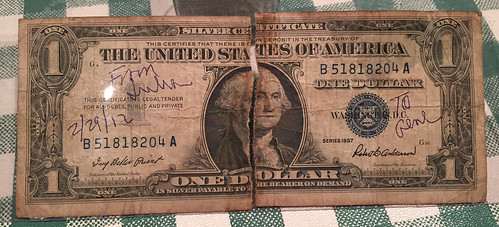
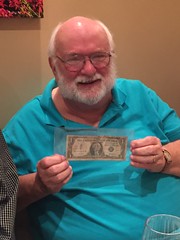
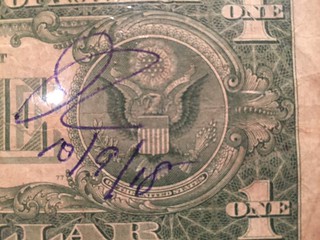
Gene and his silver certificate
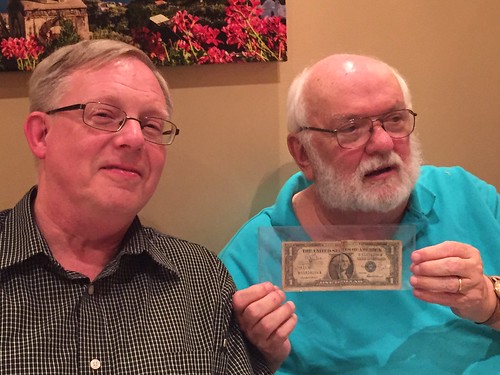
Wayne Homren and Gene Brandenburg
It is a good bet that few others have such notable items. I would rate these notes as nearly unique, and look to the writers of auction catalogs in the future to link their provenance to this dinner, those two notables, and to price them accordingly. If Gene ever decides to part with one, you should know the origin and special aspects of these rare notes, in order to bid accordingly. Knowing Gene I might look for one at auction on his eBay site soon. He may even give a discount for volume purchases.
What would you bring to a Nummis Nova dinner that would impress us? Send us your best ideas, and if you own the items, send show-and-tell notes and images, for our virtual dining and dinner conversation pleasure.
Bishop's Beauties October 2018
We'll wrap up this Diary with a great selection from Steve Bishop, starting with an impressive Franklin medal. Thanks!
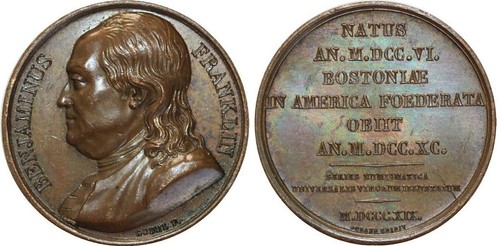
1819 Franklin Numismatica GM-45 Var Medal
Steve writes:
The Franklin medal is excessively rare: Joe Levine listed one in one of his auctions and noted that he knew of only one other.
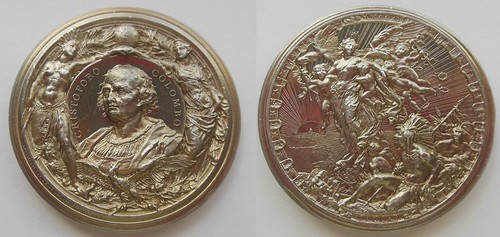
1893 Milan Columbian Exposition Medal White Metal
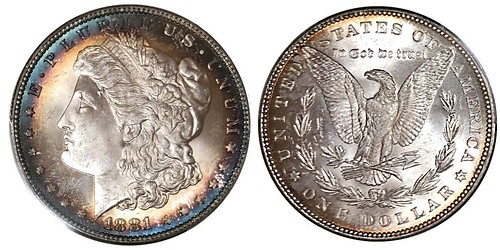
1881 Morgan PCGS MS65 Toned
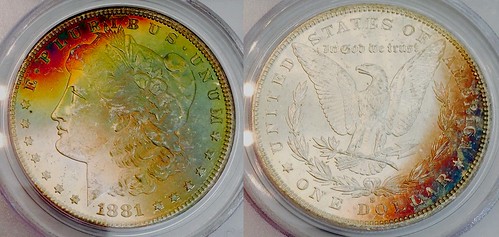
1881-S Morgan PCGS MS63 Toned
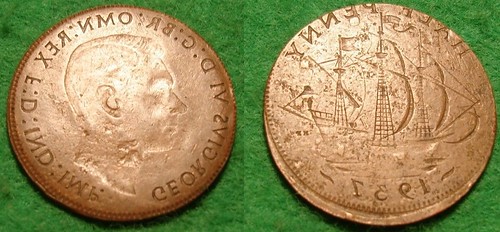
1947 Half Penny Double Brockage
Steve adds:
The "double brockage" is probably a fake made outside of the mint, although I can envision a scenario in which it could occur at the mint.

HOLEY DOLLAR AND DUMP: MEASURE TWICE, CUT ONCE
Australian dealer Andrew Crellin posted a nice article recently on his Sterling & Currency company blog about the important calculations behind the creation of the Holey dollar and Dump coins for New South Wales (NSW). -Editor
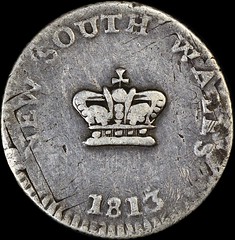
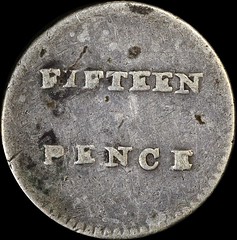
What is often overlooked in that assessment is the fact that the way the Dump was cut and struck determined whether both coins remained in circulation.
If Macquarie’s counter-stamping plan was to prevent coins from being taken outside NSW, the weight of both the Holey Dollar and the Dump needed to fall within a tightly defined range. If either coin weighed outside their intended range, its silver value could vary widely from its face value, which could be an incentive to take the coin away from NSW and pass it off at its intrinsic value, defeating the purpose of the whole exercise.
All other criteria being equal, the weight of each Dump (and thus the weight of each Holey Dollar it was cut from) was determined by the diameter of the Dump. The larger the diameter of a Dump, the heavier it is; and also the lighter the Holey Dollar it was cut from.
If the weight of each coin was to be within a tolerance that enabled the currency value of both coins to exceed its intrinsic value, Henshall needed to calculate the diameter of the Dump very precisely.
To read the complete article, see:
The Way Henshall Cut and Struck the 1813
Dump / Fifteen Pence Impacted the Viability of the Holey Dollar
(https://www.sterlingcurrency.com.au/research/way-henshall-cut-and-struck-1813-dump-fifteen-pence-impacted-viability-holey-dollar)
Wikipedia has a decent overview of the origin of Holey Dollars and dumps. -Editor
Holey dollar is the name given to coins used in the early history of two British settlements: Prince Edward Island (now part of Canada) and New South Wales (now part of Australia). The middle was punched out of Spanish dollars, creating two parts: a small coin, known as a "dump" in Australia, and a "holey dollar". This coin was one of the first coins struck in Australia.
To read the complete article, see:
Holey dollar (https://en.wikipedia.org/wiki/Holey_dollar)

MAXIMILIAN FYSCHER WORLD WAR I PLAQUE
Harry Waterson submitted this article about an interesting WWI Memorial plaque. Thanks! -Editor
Here is a plaque to remember WWI that I have never seen before. It is cast bronze, 18x14-inches, entitled IN MEMORIAM. On the bottom left is PAT. NOV. 6, 1917 BY MAXIMILIAN FYSCHER and on the right MADE FOR OUR HEROS, INC.

(It was on eBay #132804917739. On Tues 10/9/2018 it sold for $170.50)
The center of the plaque is the end of Woodrow Wilson's speech to a Special Session of Congress on 6 April 1917, the day the US declared war. Around the speech are medals inset into banded wreaths depicting eight leaders of the Allies. The other four Allies are represented with national symbols in the four corners. One medal at the bottom is missing. By process of elimination this medal was probably King Alexander of Greece.
 A little research has turned up the fact that only the Woodrow Wilson medal at the top of the plaque had a copyright. There was a 10¼-inch bronze medallion mounted on a
15-inch wide piece of Belgian black marble. It was presented to Mrs. Woodrow Wilson on December 14, 1917 by "Our Heroes." Inc.
A little research has turned up the fact that only the Woodrow Wilson medal at the top of the plaque had a copyright. There was a 10¼-inch bronze medallion mounted on a
15-inch wide piece of Belgian black marble. It was presented to Mrs. Woodrow Wilson on December 14, 1917 by "Our Heroes." Inc.
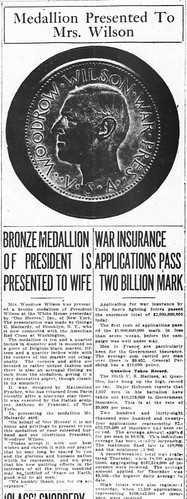 The piece was designed by Maximilian Fyscher, a well known advertising art director and the bas-relief of Wilson on the bronze medallion was sculpted by Anthony de
Francisci. By extension, the whole plaque was designed by Fyscher and de Francisci did all the portraits. The Wilson portrait on the medallion is the same as the portrait on this
In Memoriam plaque. I knew de Francisci had done a Wilson medal. It is listed in Dick Johnson's database dated 1916 but is not illustrated. This must be it. The clipping to
the right is from The Washington Times, Washington, DC Dec. 15, 1917 p4. and it is the source for the de Francisci attribution.
The piece was designed by Maximilian Fyscher, a well known advertising art director and the bas-relief of Wilson on the bronze medallion was sculpted by Anthony de
Francisci. By extension, the whole plaque was designed by Fyscher and de Francisci did all the portraits. The Wilson portrait on the medallion is the same as the portrait on this
In Memoriam plaque. I knew de Francisci had done a Wilson medal. It is listed in Dick Johnson's database dated 1916 but is not illustrated. This must be it. The clipping to
the right is from The Washington Times, Washington, DC Dec. 15, 1917 p4. and it is the source for the de Francisci attribution.
I am a bit of a collector of Woodrow Wilson profile portraits and I have searched for this medal for a couple of years. I currently have a Woodrow Wilson Profile Puzzle in the September issue of the MCA Advisory. It is amazing to come across this medal much less all this work by de Francisci in one place all on one piece. At the end of the war de Francisci would design and sculpt the Peace Dollar.
A careful look at the empty socket at the bottom of the plaque reveals that someone has worked the piece of solder left behind when the medal was removed and smoothed it out. He then carved into it a profile of an American Indian. In the spirit of "Kilroy was here." I would suggest that some Hobo Nickel artist saw a target of opportunity and added this portrait to the plaque. It certainly makes this plaque a very unique addition to the wall of the very advanced collector.
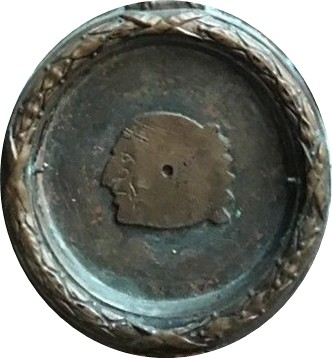

THE OVEREND WWI FRENCH MEDAL COLLECTION
Harry Waterson also published a great article in the October 2018 issue of The Clarion from the Pennsylvania Association of Numismatists. With permission, here is an excerpt. -Editor
Collections are often very personal. This is about a collection of medals put together at the end of WWI in France by Captain Harrison G. Overend (1890-1957). 1 Harry Overend was born in Peoria, IL, attended Ipava High School and Bradley Polytechnic Institute - now Bradley University - in Peoria. He graduated from the University of Illinois in 1917 with a BS in Architecture. On August 15, 1917 he went on active duty as a 2nd Lt., 14th US Infantry, Vancouver Barracks, WA and on October 25th he was promoted to 1st Lt. in the Coast Artillery Corps (CAC) stationed at Ft. Warren in Boston harbor, MA. He was appointed temporary Captain on May 20th, 1918 in command of Battery B, 71 ST Artillery Regiment, CAC. The Regiment sailed on the SS Margha for Liverpool via Halifax July 31. They landed on August 15th, were held briefly at Camp Standon in Hertfordshire and then sailed for France from Southampton August 29th on the SS Charles arriving in Le Havre one day later.
The 71 ST Artillery Regiment was assigned to Organization and Training Center No. 4 (O&TC) in St. Sylvain where they went into training with heavy guns both stationary and mounted on railroad cars. Still training when the Armistice was signed, they remained in France until February, 1919 when they sailed back to the US and were demobilized at Camp Devens, MA on March 6, 1919. Captain Overend did not return with his unit. On January 24, 1919 Overend was assigned as an Intelligence Officer to the American Embarkation Center, Le Mans, France.
In the spring of 1919 Overend received a month's leave and went to Winchester, England where he spent his time in Winchester Cathedral making prints of inscriptions by rubbing a wax over tracing paper placed on the brasses. The four oldest brasses he traced dated from 1433 to 1494. He sent the tracings to the romance language department at the University of Kansas at Lawrence to be translated and made available to scholars. 2 Overend was an unusual young man.
Harry Overend returned to the US on the SS Cap Finisterre sailing from Brest, France on August 7, 1919. He resigned his commission September 18, 1919 and moved to Wichita, KS where he joined the architectural practice of Lorentz Schmidt. Schmidt recruited fellow architectural graduates from the University of Illinois who were mostly members of the Alpha Rho Chi National Architectural fraternity. He recognized the six graduates who joined him in 1919 by changing the name of his firm in 1920 to Lorentz Schmidt & Company. It is easy to trace the career of Harry Overend by following the arc of the name changes of the firm. By the mid 1920s it was Schmidt, Boucher & Overend and by 1933 it was Overend & Boucher, Architects. Their practice centered on institutional buildings with the Diocese of Wichita and related Catholic organizations being the source of many major commissions. Harrison G. Overend married Pearl L Stewart in 1924 and they had one son, Donald Stewart in 1927.
Harry Overend returned to the US from France with two collections. On the 13th of February, 1923 he exhibited his collection of French war posters for a program on commercial art at the Twentieth Century Club in Wichita. 3 The posters whereabouts today are unknown. He also collected a small number of medals which have managed to stay together to today. They went from father to son to the son's widow and will pass on to a grandchild still intact. This happens very rarely and the collection is well worth a close examination. What did Harry Overend choose to bring back out of all the memorabilia available to him in France?
Joan of Arc, Liberator of the Land - 1900
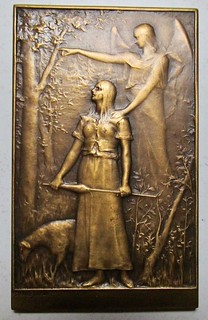
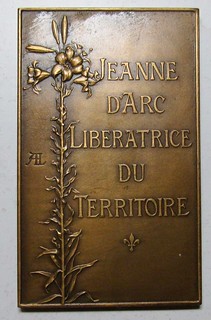
Jean-Baptiste Daniel-Dupuis (1849-1899) French sculptor. JEANNE D'ARC, LIBERATRICE DU TERRITOIRE. Joan of Arc, Liberator of the Land. Bronze plaquette, 67x40mm. Shows peasant girl among sheep with Michael the Archangel and leader of the angelic militia on a hill behind offering Joan guidance and direction. Last medal by Dupuis before his tragic death. Reverse by his friend Alphonse Lechevrel (1848-1924). Lechevrel used seven lilies three still in bud on a single stalk to symbolize the Lily Maid. Silver and looped versions are known.
Joan of Arc was the French national saint who forced the English to abandon the siege of Orleans in 1429 during the Hundred Years' War. She also played a decisive role in the Coronation of Charles VII in Rheims. She was burned at the stake in 1431 as an alleged heretic.
Daniel-Dupuis was one of the most important figures in the revival of medallic art in France. He was made Chevalier of the French Legion of Honour in 1881. He received a gold medal at the Universal Exhibition in Paris in 1889 and was promoted to Officer of the French Legion of Honour in 1891. In addition to an impressive number of medals and plaquettes, he also produced coins for France and Indochina, drawings paintings and watermarks for banknotes as well as statues and bas-reliefs, including works for the Hotel de Ville in Paris.
The Women of the Red Cross - 1916
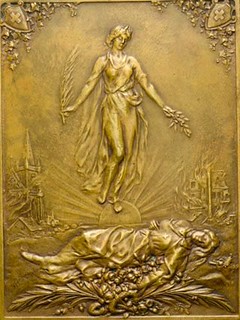
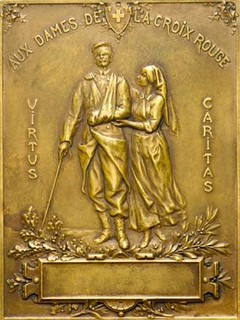
Henri Emile Allouard (1844-1929) French sculptor. AUX DAMES DE LA CROIX ROUGE The Women of the Red Cross, 70x52mm plaquette, bronze. Obverse: angel rising over a dead Red Cross nurse, pistol lying by her head dropped by a German soldier as he flees. Reverse: a Red Cross nurse aiding a wounded soldier flanked by the words Virtue and Charity. Cartouche below.
The 'smoking gun' in the plaquette is a reference to the prominent nurse Edith Cavell (1865–1915). A British nurse she is celebrated for saving the lives of soldiers from both sides without discrimination. She helped some 200 Allied soldiers escape from German-occupied Belgium, for which she was arrested. She was accused of treason, found guilty by a court- martial and sentenced to death. Despite international pressure for mercy, she was shot by a German firing squad. Her execution received worldwide condemnation.
The night before her execution, she said "Patriotism is not enough. I must have no hatred or bitterness towards anyone." These words were later inscribed on a memorial to her near Trafalgar Square. Her strong Anglican beliefs propelled her to help all those who needed it, both German and Allied soldiers. She was quoted as saying, "I can’t stop while there are lives to be saved."
Henri Allouard was known for his combinations of polychrome marbles and bronze, he also worked in terracotta, ivory and precious metals. He was the author of sets painted at the Parthenon, at the Paris Opera and at the City Hall of Paris. He was representative of the of the neo-baroque influence in sculpture.
The Battle of Verdun - 1917
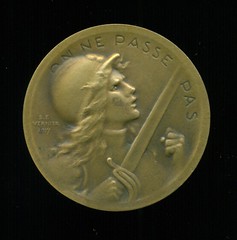
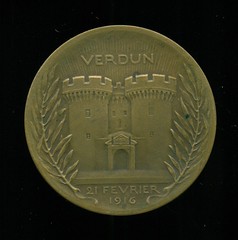
Emile-Seraphin Vernier (1852-1927) French sculptor. The Battle of Verdun medal (Feb.21, 1916 - Dec. 18, 1916) Bronze, 26mm looped. Issued in 1917 to all who participated in the battle by the City of Verdun to commemorate the city's defense. Later the distribution of the medal was expanded to anyone who served on the Argonne and St. Mihiel sectors between 31 July 1914 and 11 November 1918. ON NE PASSE PAS. "They shall not pass." is a quote from a speech by General Robert Nivelle to his troops on June 23, 1916.
The medals, medalets and plaquettes have been organized in chronological order. When this was done the writer was struck by the narrative he got from these lovely pieces of bronze, all but one signed by the talented French sculptors who created them. They were collected by a soldier who saw the parallel in the 15th Century liberation of France by an almost mystical intervention and the 20th Century liberation of France by the massive intervention of the American Expeditionary Force (AEF). The 1908 Victory plaquette is one that would acknowledge achievement in sports or scholarship, not the battlefield. The run from 1915 to 1918 graphically depicts the horrors the French had endured since the German invasion. They had to defend their homeland, care for their wounded, send husbands and sons to fight and die, fight battles, including one that lasted almost a year. Finally with the intervention of the AEF, victory. Hence the French victory medal that shows the American influence.
This collection does not seem like a haphazard potpourri picked up in an afternoon but rather one thoughtful soldier's careful assembly of pieces chosen to reflect his thoughts and ideas about his experience of the Great War. This writer is ever grateful that he had a chance to look at and hold these medals 100 years after Harry Overend gathered them together, put them in a box and brought them back to Kansas.
THE BOOK BAZARRE
HIDDEN MESSAGES IN HAY INTERNMENT CAMP NOTES
Another nice article from Australian dealer Andrew Crellin's Sterling & Currency company blog concerns hidden messages in the design of Hay Internment Camp notes. -Editor
The story of the men that created the notes used in the Hay Internment Camp was recounted in popular culture most explicitly in the 1980's TV series produced by the BBC titled "The Dunera Boys". The full story of the notes is far less well known - particularly the fact that the designs either side contain a range of "hidden" messages within them.
The "Dunera Boys" included musicians, artists, philosophers, scientists and writers - their living facilities at Camp Hay were basic, many said that was boredom that was the greatest enemy.
Internees organised educational and artistic projects, including lectures, concerts and camp newspapers. One such project was the creation of these currency notes that were intended to be used within the confines of the internment camp. The designer of the notes, George Teltscher, clearly revelled in the intellectual and artistic challenge that the design process offered, as he deployed several design devices that have proven to have an enduring appeal to historians and collectors.
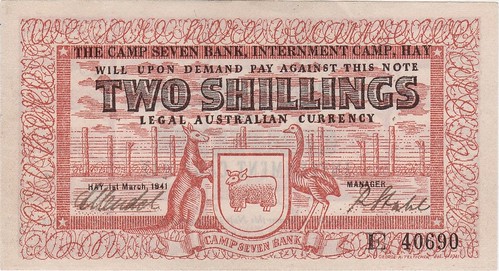
Aficionados of these notes have long known that three relatively obvious hidden messages can be found in the simultan designs across the front of the note:
1. The designer’s name “Eppennstein” can be seen within the fleece of the merino;
2. The phrase “We Are Here Because We Are Here” can be seen in the barbed wire perimeter of the note; and 3. The phrase “HMT Dunera Liverpool to Hay” can be seen in the barbed wire running across the face of the note, on the ground at the base of the fence poles.
Research in recent years has determined that the back of the notes are also thought to contain hidden text. Although this research is not yet complete, the names of each of the internees that were assigned to Hut 26 at Camp 7 in Hay are believed to be hidden within the fleeces of the 25 merino rams.

To read the complete article, see:
Hidden Messages and Micro Code -
Teltscher's Is Still Skill Studied 8 Decades Later
(http://www.sterlingcurrency.com.au/research/hidden-messages-and-micro-code-teltschers-still-skill-studied-8-decades-later)
Andrew Crellin adds:
If you’d like to look further into the conspiracy theory regarding the micro lettering that is apparently incorporated into the designs of the Hay Internment notes, links to the website and Youtube videos published by the amateur historians I referred to are below:
SOMERTON MAN: THE FULL STORY PART 1. THE LINK TO HAY, JESTYN, ALF BOXALL AND TIBOR KALDOR PROVEN.. TORN PIECE REVEALED (https://tamamshud.blogspot.com/2016/12/somerton-man-upcoming-post-alert.html)
SOMERTON MAN: Overview of a Hay Internment Camp 2 Shilling note (https://www.youtube.com/watch?v=vCfOUdpIzo0)
2 Shillings HAY Internment Camp Banknote (https://www.youtube.com/watch?v=tdAMpqywHDc)
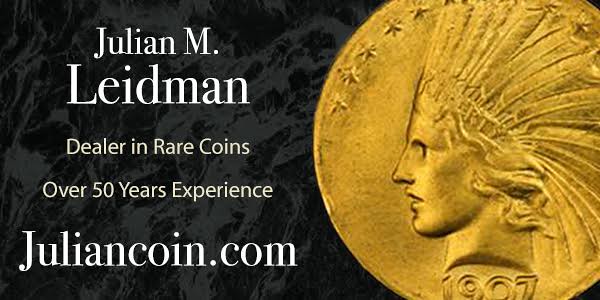
BANK OF ENGLAND ANNOUNCES £50 NOTE CHANGES
Arthur Shippee forwarded this story from BBC News. Thanks! -Editor

Fears that the largest denomination was widely used by criminals and rarely for ordinary purchases had prompted a proposal to abolish it.
But ministers said the new version, to be printed in the UK, would be more durable, secure and harder to forge.
Polymer £5 and £10 notes are already in circulation, while a £20 design will be issued in 2020.
There are currently 330 million £50 notes in circulation, with a combined value of £16.5bn, the bank said.
Some vegans, Hindus and Sikhs have voiced concerns about the move to polymer bank notes, however, after they were found to contain traces of animal fats.
The decision will also raise questions over which famous Briton will feature on the reverse of the note.
Steam engine pioneers James Watt and Matthew Boulton appear on the current £50, issued in 2011.
Jane Austen was chosen to appear on the plastic £10 note after a campaign to represent women other than the Queen on English notes.
The Bank of England now has a committee which asks for public nominations in a chosen field.
To read the complete article, see:
The £50 note is changing and here's why (https://www.bbc.com/news/uk-45850135)
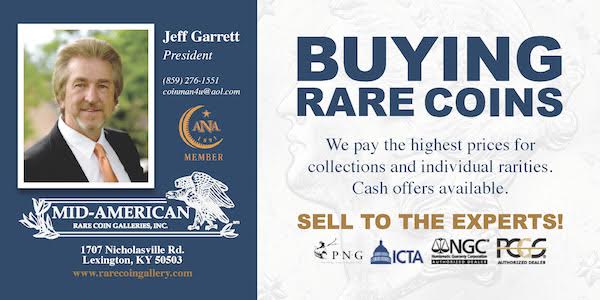
'HIDDEN SECRETS' OF THE $1 BILL
Howard Daniel passed along this MSN piece about "30 hidden secrets of the $1 bill." A couple are odd, like the "spider" and "ghost" seen in the design, but most are correct. Here are some I liked. -Editor
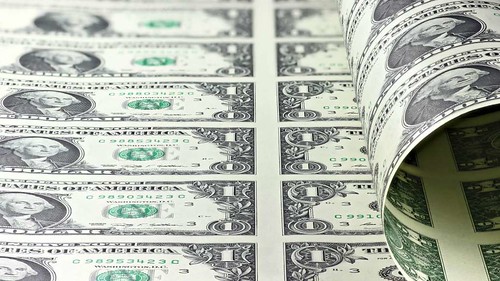
3. The $1 Bill Design Hasn’t Changed Since 1963
The $1 bill design has remained unchanged since 1963. The main reason is that the $1 bill is infrequently counterfeited. In addition to counterfeiting, there’s also a legislative
reason. Section 116 of the Financial Services and General Government Appropriations Act prohibits spending money to redesign the $1 note.
6. It’s Not Made of Paper
We might call it paper money, but it’s not actually paper. In fact, currency paper in the U.S. is 75 percent cotton and 25 percent linen, according to the Department of the
Treasury.
14. The Latin Around the Pyramid Speaks to American Exceptionalism
“Annuit Coeptis,” which is written above the pyramid, means “Providence Has Favored Our Undertakings.” Below the pyramid, the words “Novus ordo seclorum” mean “A New Order of the
Ages,” which refers to the United States’ historic form of government.
18. You Can Tell Which Federal Reserve Bank Issued It
On your dollar bill, there are serial numbers with two letters and eight numbers. The first letter — which will be between A and L — indicates which bank issued the bill. The
letters stand for:
- A = Boston
- B = New York
- C = Philadelphia
- D = Cleveland
- E = Richmond, Va.
- F = Atlanta
- G = Chicago
- H = St. Louis
- I = Minneapolis
- J = Kansas City, Mo.
- K = Dallas
- L = San Francisco
26. You Can Buy Uncut Sheets of $1 Bills
The general public is allowed to buy uncut sheets of currency from the Bureau of Engraving and Printing. You can order by phone or on the bureau’s website.
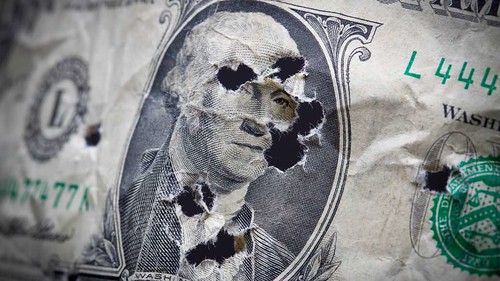
I didn't know about the legislation mentioned in #3, although having read it, it sounds vaguely familiar. Anybody have the backstory on that? -Editor
To read the complete article, see:
30 hidden secrets of the $1 bill
(https://www.msn.com/en-us/money/markets/30-hidden-secrets-of-the-dollar1-bill/ss-AAyIBS0?li=BBnb7Kz&ocid=HPDHP17)

AUDIO: THE STORY OF MONEY
Arthur Shippee forwarded this trio of stories about money from the WNYC On the Media radio program, which aired October 12, 2018. Thanks! -Editor
Ten autumns ago came two watershed moments in the history of money. In September 2008, the bankruptcy of Lehman Brothers triggered a financial meltdown from which the world has yet to fully recover. The following month, someone using the name Satoshi Nakamoto introduced BitCoin, the first cryptocurrency. Before our eyes, the very architecture of money was evolving — potentially changing the world in the process. In this hour, On the Media looks at the story of money, from its uncertain origins to its digital reinvention in the form of cryptocurrency.
1. The life and work of JSG Boggs, the artist who created hand-drawn replicas of currency that he used to buy goods and services. With Lawrence Weschler and MIT's Neha Nerula.
2. A brief history of money with UC Irvine's Bill Maurer and Mark Blyth from Brown University.
3. How cryptocurrency could shape the future of money, with MIT's Neha Nerula, New York Times' Nathaniel Popper, Vinay Gupta of Mattereum, Brown University's Mark Blyth and artist Kevin Abosch.
To read the complete article, see:
Full Faith & Credit (https://www.wnycstudios.org/story/on-the-media-2018-10-12)
Give them a listen - these are well-done and thought-provoking pieces about the nature of money itself. The first segment is about money artist J.S.G. Boggs. -Editor
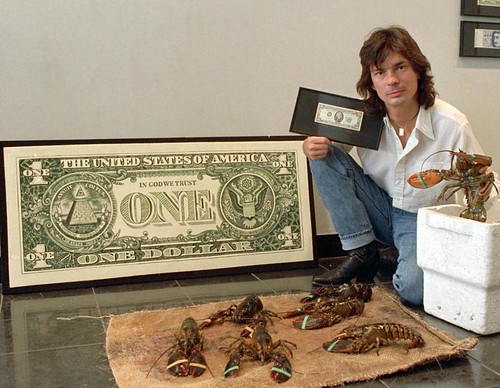
Artists, it seems, can at times create money out of thin air. Think of Damien Hirst exploding the art market in the 1990s with dead animal displays and spin-art paintings, of Andy Warhol printing a sheet of 2 dollar bills. Jackson Pollack, it’s said, used to settle his bar tab with paintings. And then there was J.S.G. Boggs, who would create astonishingly detailed replicas of existing currency, from the US dollar to the British pound to the Swiss Franc, and then use them to pay for goods and services. Bob speaks with Boggs's biographer Lawrence Weschler, author of Boggs: A Comedy of Values, about how Boggs used his artwork to explore fundamental questions about the nature of money. He also speaks with the MIT Digital Currency Initiative's Neha Nerula about money's underlying value.
The second piece concerns how money came to be, and it pokes a hole in the concept of barter as the origin of money. "In the beginning was not the coin, but the receipt." -Editor
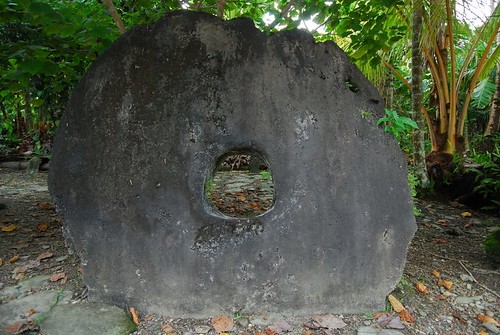
Most schoolchildren learn that money arose when barter proved insufficient for meeting everyday trade needs. People required more complex transactions, so they invented currency: a medium of exchange, unit of account and store of value. It's a compelling story...but a false one. Instead, most evidence suggests that money arose from recordkeeping — or, as UC Irvine professor Bill Maurer explains to Bob, "in the beginning was not the coin... in the beginning was the receipt." In this segment, Bob speaks with Maurer and Brown University's Mark Blyth about past and present myths about money, and what the history of money might suggest about its future.
The last piece is about the development of cryptocurrency. -Editor
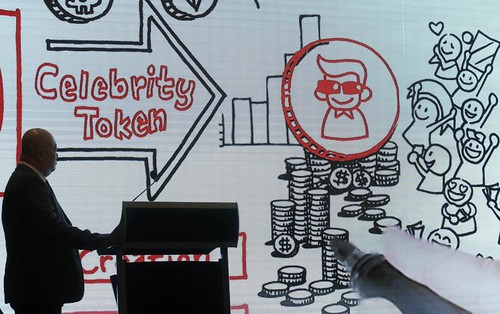
The economy is the ultimate exercise in collaboration — with collaborators you don’t necessarily choose, such as governments, which can impoverish you with the stroke of a pen. In response to this vulnerability, a person (or persons) working under the name Satoshi Nakamoto launched Bitcoin, a peer-to-peer currency with a fixed number of tokens, built on a distributed, indelible ledger. Ten years into the life of the cryptocurrency, it has a market cap in the billions of dollars, and has given rise to thousands of copycat and competitor currencies, all built on their own communities and visions of the future. But in many ways, the underlying principle — faith — is as central to the value of money as ever. Bob speaks with Vinay Gupta, Nathaniel Popper, Neha Nerula, Mark Blyth and Kevin Abosch about how cryptocurrency fits into the evolution of money.

LOOSE CHANGE: OCTOBER 14, 2018
Here are some additional items I came across in the media this week that may be of interest. -Editor
Selected Harlan J. Berk 206th Buy or Bid Sale Lots
Michael Markowitz of CoinWeek highlighted a number of choice lots in the Harlan J. Berk 206th Buy or Bid Sale. Here's one that particularly caught my eye. -Editor
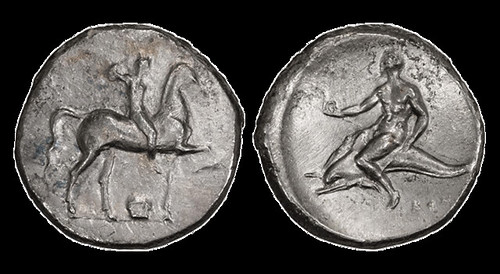
Calabria, Tarentum; c. 325-281 BC, Stater, 7.76g. Vlasto-657. Obv: Naked horseman r., crowning himself, S? and Ionic capital below. Rx: Taras on dolphin l., holding sea-snake; KOM below. Taras holds a sea snake in his hand which is very clear in this coin. Sea snakes are always poisonous, but rarely aggressive. The reverse of this coin is beautifully designed and wonderfully struck. EF / Mint State
To read the complete article, see:
Harlan J. Berk 206th Buy or Bid Sale: Ancient Coin Lots You Need to
Know (https://coinweek.com/recent-articles-video/harlan-j-berk-206th-buy-or-bid-sale-ancient-coin-lots/)
The Purchasing Power of Ancient Coins
To read the complete article, see:
What Were They Worth? The Purchasing Power of Ancient Coins
(https://coinweek.com/education/worth-purchasing-power-ancient-coins/)

THE LARGEST COIN PYRAMID IN THE WORLD
Kavan Ratnatunga of Sri Lanka forwarded this Atlas Obscura article on the largest coin pyramid in the world. Thank you. -Editor
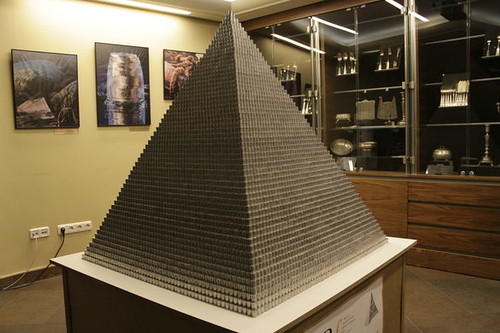
On January 1st, 2015, Lithuania officially changed their national currency to the euro, joining many other European nations in using the widely accepted monetary system. So, to celebrate, they broke a world record with a pyramid made out of their disused coins.
The project was the brainchild of two Lithuanian physics students, Vytautas Jakštass and Domas Jokubauskis, who wanted to create a fitting memorial to the currency they grew up with. To this end, the pair designed a pyramid created out of over a million one-cent pieces. The project began with much simpler goals, but as the collecting began, they found that they had many more coins on their hands than they had anticipated and the triangular monument was proposed. Whether the creators intended a symbolic connection between the death of their former coin (the lita) and the funereal purpose behind the iconic Egyptian pyramids is unknown.
Built on a table in the Bank of Lithuania’s money museum, the heavy monument reaches over a meter tall and was stacked over three weeks prior to the new year. The pyramid marks the single largest coin pyramid in the world according to the creators. When the monument is made to come down the intention is to donate the coins to children’s charities, assumedly before the lita is no longer accepted in favor of the euro.
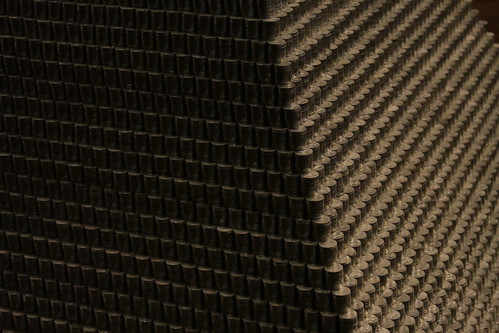
To read the complete article, see:
One Million Cent Pyramid (https://www.atlasobscura.com/places/one-million-cent-pyramid)

